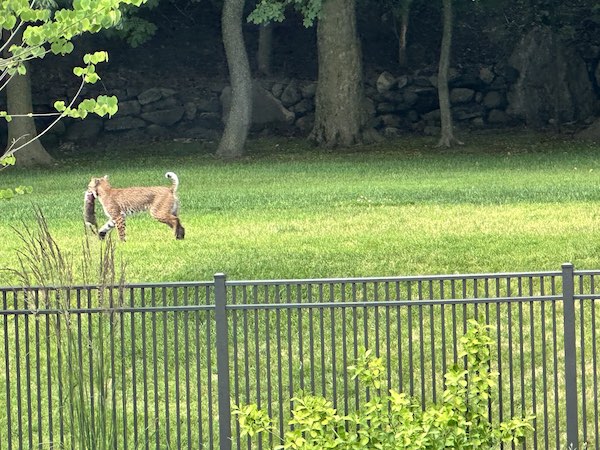Another Bobcat Sighted in Scarsdale
- Tuesday, 08 August 2023 17:48
- Last Updated: Thursday, 07 December 2023 08:31
- Published: Tuesday, 08 August 2023 17:48
- Joanne Wallenstein
- Hits: 4370
 When we saw that someone reported sighting a bobcat in their yard a few weeks ago, we assumed they were mistaken. But now we know that the report was probably true.
When we saw that someone reported sighting a bobcat in their yard a few weeks ago, we assumed they were mistaken. But now we know that the report was probably true.
Jeremy Gans spotted this bobcat in his yard in Quaker Ridge and caught him on his camera. Gans said, “We had one in our backyard about a month ago. It was definitely a bobcat and it had apparently gone hunting in the yard." Gans called police who said it is not unusual to see a bobcat in Westchester but they are usually nocturnal. He was told that as long as the bobcat was healthy it should not bother people, but pets would be at risk.
This one looks like he has a rabbit in his mouth!
DEC Wildlife Biologist Mandy Watson said bobcat attacks on humans are very rare, however it is still important to exercise caution. If you see a bobcat, do not approach it and make sure to supervise small pets, especially at night. Always walk dogs on a leash and anyone who has poultry or other livestock should make sure they are in a secured, predator-resistant area.
Here’s what the NYS Department Environmental Conservation says about bobcats:
Bobcats are about twice the size of a domestic cat and usually smaller than the Canada lynx. Their fur is dense, short, and soft-is generally shorter and more reddish in the summer but longer and more gray in the winter. Spotting occurs in some bobcats and is faded in others. The face has notable long hairs along the cheeks and black tufts at the tops of each ear. Males are, on average, one-third larger than females. Both sexes can be greater than 30 pounds; however, averages for males and females are 21 and 14 pounds, respectively. Body length for males is 34 inches and 30 inches for females. Tail length is usually between 5 and 6 inches for both sexes.
You can scare away a bobcat by yelling or making other loud noises. These tips will also help prevent conflicts with coyotes.
Bobcats are solitary animals and may be active at any time, day or night. Males have larger home ranges than females, and they travel greater distances on a daily basis. The average home range of a male in the Adirondacks is 136 square miles. The average female home range is 33 square miles. In the Catskills, the average male home range is 14 square miles, while the female average is 12 square miles. Home ranges are smaller in areas of good habitat than in areas of poor habitat. Scent marking using feces, urine, and scrapes of fluid from their anal glands have all been documented as ways they mark territory, and are commonly found on the underside of leaning trees, logs, shelter rocks, or stumps.
Bobcats will use multiple strategies while hunting. They may approach stealthily, using any form of cover available between them and their prey, attempting to get close enough to pounce and strike. They may also use an ambush technique where they will sit and wait for prey to pass by, to strike undetected. Smaller prey items such as mice and birds are consumed whole. Larger animals taken and stored are eaten in the position they lay, and can be identified as a bobcat cache (food stored for future use) if the upper parts were consumed, while the portion of the cache in contact with the ground may be untouched.







